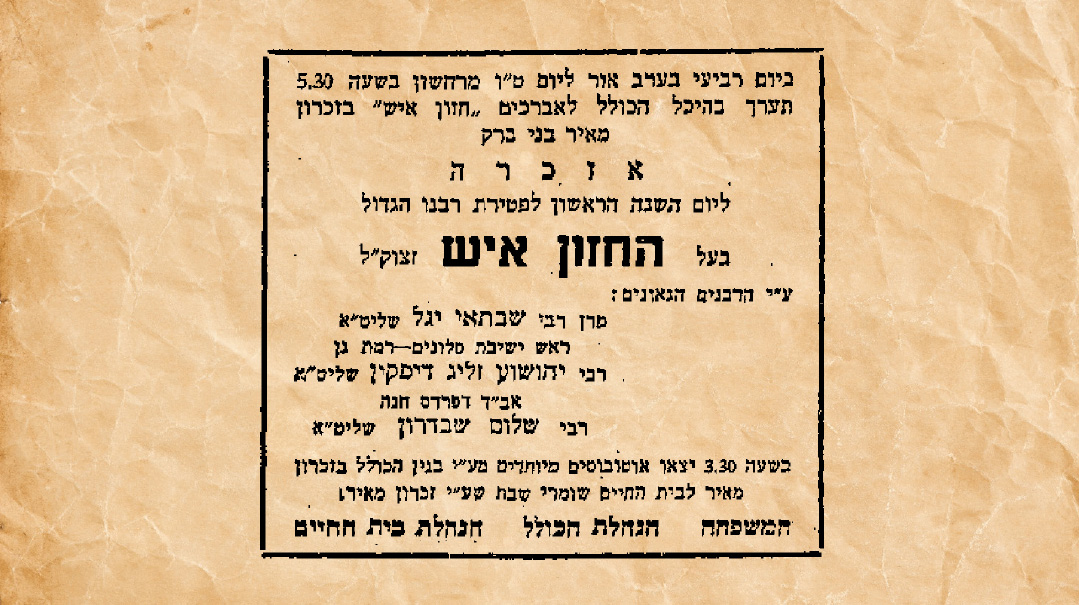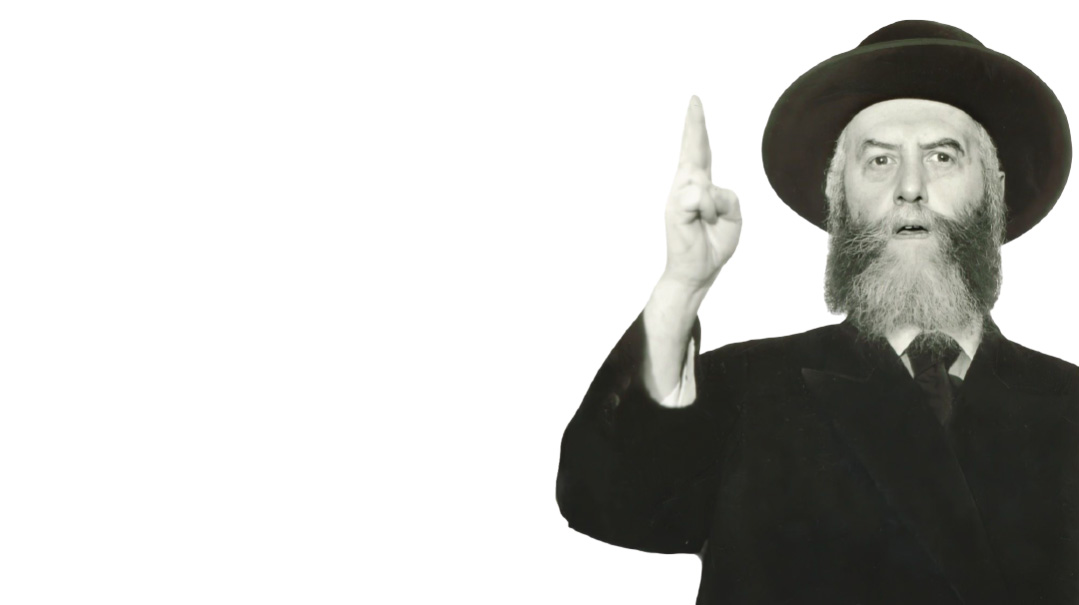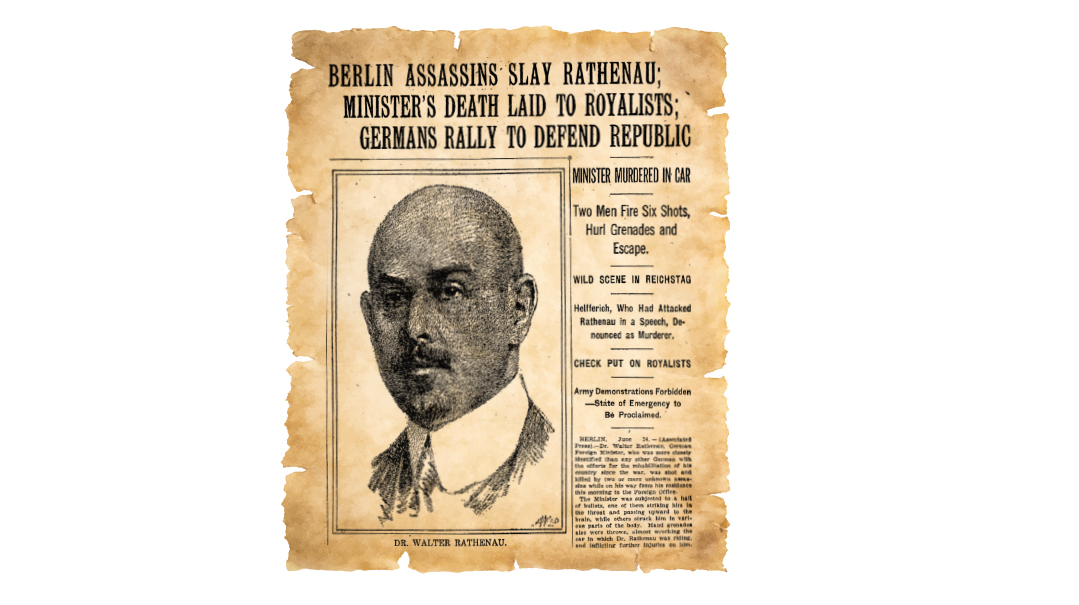The Voice of the Maggid
| November 28, 2023Rav Sholom Schwadron’s reputation as a maggid stemmed from his natural public speaking talents

Title: The Voice of the Maggid
Location: Jerusalem, Israel
Document: Yahrtzeit Sign
Time: November 1954
One Friday night in 1952, a brilliant 40-year-old talmid chacham named Rav Sholom Schwadron made his way from his modest two-room home in Jerusalem’s Shaarei Chesed neighborhood to the central shul of the Zichron Moshe neighborhood. The crowd in attendance listened as he wove a tapestry of halachah, parshah, and fiery words of mussar in a masterful display of oratory skills. The Leil Shabbos Zichron Moshe shmuess would continue unabated for more than four decades, and would cement Rav Schwadron’s legacy as the beloved “Maggid of Yerushalayim.”
Rav Sholom Schwadron’s reputation as a maggid stemmed from his natural public speaking talents. While the content was engaging and his message authentic, it was his delivery that captivated his ever-growing audiences. He had mastered the art of varying his tone throughout his narrative to build suspense, and upon reaching the climax of his mussar message — exhorting his audience to improve their behavior — he’d switch to a singsong emotional appeal to their better selves. He utilized an arsenal of stories of tzaddikim and folktales; his knowledge of Jewish history was a veritable warehouse; and he peppered his talks with witticisms and jokes. Rav Sholom was skilled at reading his audience and their diverse levels of engagement, and no soul remained untouched when exposed to his charismatic personality.
The beneficiaries of his dynamic speeches weren’t limited to the Leil Shabbos Zichron Moshe crowd. He delivered two daily Gemara shiurim to Shaarei Chesed residents, served as the mashgiach for several years at Yeshiva Tiferes Tzvi for younger students, and for a decade was the senior maggid shiur at the Mekor Chaim Yeshivah for Sephardic students.
At the behest of Rav Yitzchak Zev Soloveitchik, the Brisker Rav, Rav Sholom emerged as the unofficial spokesman for the nascent P’eylim organization following its establishment in the early 1950s. P’eylim was active among the new immigrant communities, providing religious education for the youth and religious infrastructure for traditional immigrants. Rav Sholom brought the message of P’eylim to broader society and was the organization’s voice at many of its public rallies.
As a result, the Maggid of Yerushalayim became the most sought-after speaker in the religious community, serving as the keynote speaker for many events on behalf of a wide array of causes, and especially rallying crowds with his inspirational message at gatherings of the religious community in Israel.
Rav Sholom soon began making monthslong trips to the US and other countries, ostensibly fundraising on behalf of the various institutions with which he was involved. He was soon inundated with requests to speak and inspire audiences at shuls, yeshivos, communities, or institutions. Rav Sholom inspired Jews worldwide with words of Torah, mussar and teshuvah, mesmerizing his listeners with his uncanny ability to bring the words of Chazal alive through anecdotes, humor, and real-life practical applications. His many trips abroad over the decades broadened his impact, such that he was truly the Maggid of Klal Yisrael, and not just of Yerushalayim.
Rav Sholom was born in Jerusalem’s Beis Yisrael neighborhood in 1912. As the first grandchild born following the passing of his illustrious paternal grandfather Rav Sholom Mordechai Schwadron, the Maharsham of Brezhan, one of the leading poskim in Galicia in the 19th century, he proudly carried his name. Rav Sholom would go on to publish many of his grandfather’s Torah works, devoting significant energies and funds to the goal. This included both the multivolume Sh’eilos U’teshuvos Maharsham and Daas Torah Maharsham. In addition, Rav Sholom edited and published the works of two of his own rebbeim, great 20th-century mussar giants: Lev Eliyahu of Rav Eliyahu Lopian; and Ohr Yahel of Rav Leib Chasman, the latter his mashgiach in Chevron Yeshivah.
Rav Sholom was orphaned from his father at age seven, and his poverty-stricken mother was unable to provide for him. He was ultimately placed for several years in the Diskin orphanage, then on Rechov Haneviim. This experience as an orphan had a decisive impact on his character, and would shape his sensitivity to others’ pain and challenges for the rest of his life.
He’d go on to study for seven years at the prestigious Chevron Yeshivah. As one of its elite budding scholars, he married Leah Auerbach, daughter of Rav Chaim Leib Auerbach, the rosh yeshivah of Shaar Hashamayim. He developed an extremely close relationship with his brother-in-law Rav Shlomo Zalman Auerbach, and as neighbors in Shaarei Chesed, they studied together as chavrusas for many years.
The Sound of Silence
The impact of his speeches was perhaps accentuated by his common practice of taanis dibbur. Every Monday and Thursday, and for the 40-day period from Rosh Chodesh Elul through Yom Kippur, Rav Sholom abstained from all mundane speech. For nearly a half century, he served as the chazzan on the Yamim Noraim at his alma mater the Chevron Yeshivah, and his unique nusach has spread throughout Israel and beyond. One of his favorite melodies came to be known as “Rav Sholom’s Niggun,” and was immortalized by Abie Rotenberg in the song, “The Place Where I Belong” on Journeys I.
Kollel of the Stars
Following his marriage, Rav Sholom Schwadron studied for several years at the elite Ohel Torah Kollel, one of the first of its kind in Jerusalem. Established in 1930 by Rav Moshe Mordechai Epstein and Rav Isser Zalman Meltzer, it became the responsibility of Rav Shmuel Yitzchak Hilman upon his arrival in Eretz Yisrael from England in 1934. Its curriculum focused on Choshen Mishpat and Even Ha’ezer to prepare its members for careers in the rabbinate. Regular shiurim were delivered by Rav Hilman’s son-in-law, the chief rabbi Rav Yitzchak Isaac Herzog. During those years its members included Rav Shlomo Zalman Auerbach, Rav Yosef Shalom Elyashiv, Rav Betzalel Zolty, Rav Shmuel Wosner, Rav Shlomo Shimshon Karelitz, and Rav Yisrael Grossman.
Rav Sholom Schwadron’s yahrtzeit is 22 Kislev
(Originally featured in Mishpacha, Issue 988)
Oops! We could not locate your form.






